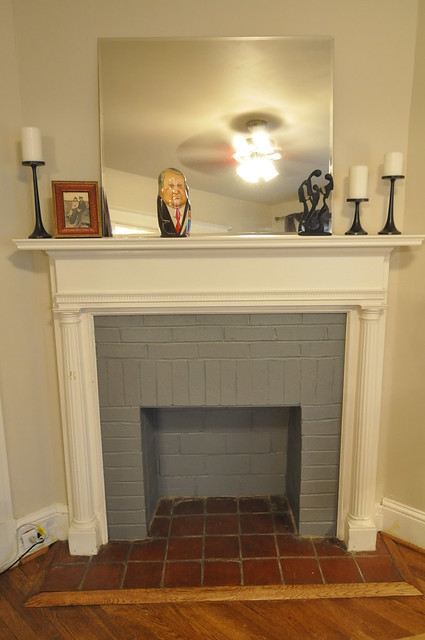Small projects make a big difference: repainting the fireplace
It’s awesome to have a fireplace in your living room, right? Cozy fires in the winter and saving money on gas bills by building a sweet fire to warm the house. Ah, that’s the life! A very distant second place is having a fake fireplace. (More like a second place finisher that’s still in the starting blocks when the winner crosses the finish line. That sort of “distant”.) Shortly after we bought the house, I remember getting on my back and looking up the shaft of the fireplace…. aaaannnnd seeing the subfloor in my closet in the master bedroom above.
But it wasn’t all bad. It did come with the next best thing to a real fireplace — fake fire logs!
It was complete with an orange lightbulb and a plug-in motor that turned a wheel in the center that had paper attached to it. As it turned, it would scrape the plastic top and bottom and make a sound like a fire crackling. Just like a real fire would! And if you got down close — no, I mean REAL close — to that little 40 watt orange bulb underneath, you could warm your hands and pretend that you had an awesome fire in the living room.
Our house does have a small chimney which runs down to the basement to ventilate the coal or oil-fired boiler that the house had for the first few decades. Next to that chimney is a pipe for the radiator expansion tank that’s still in my closet to this day — the tank that would take in the extra water from that boiler so the closed loop radiators wouldn’t explode from the expansion of hotter water. Both of these things protrude from this north wall, so the fireplace was built (or added, as it were) mostly to provide a decorative cover for them.
I’m not really sure when it was put into the house, but I suspect that it wasn’t part of the original installation when the house was delivered in 1921. For one, the trim around it doesn’t match the trim in the rest of the house, the brick surround and the tile floor doesn’t match the house brick or finishes and the level of craftmanship on the whole thing definitely is not up to par with the rest of the house’s quality.
The rough sandy brown bricks didn’t really match our decor, and Rachel had been on me to repaint them for a couple of months. While GranMarty was here to help with Lily a few weeks ago, I finally knocked it out in a day, with a pit stop in the world of “oops, THAT was the wrong color!”
After repainting the dining room with the light grey over the chair rail and a darker shade of grey below (that we love), we’d been planning to continue those colors into the living room one day and get a new couch to match when this one has outlived its usefulness. And then transform the color palette from the brownish (Behr Roman Plaster) to grey.
So the bricks made the transition first. To prime the bricks, instead of a normal oil- or water-based primer, I used the Behr concrete primer (no. 880) that I was intending to use for the front porch steps — which I never used because we decided to leave them unpainted after stripping them bare. It works great for porous materials like brick because it contains epoxy to help penetrate and fill all the holes. After brushing the bricks as clean of dust as possible, I ended up doing at least a few coats to make sure it was well covered. The primer is white and fairly watery, so a few coats is a good idea to make sure you’ve gotten good coverage. Once it dries, the surface is a bit tacky, and stays that way until you paint it.
For the paint color, we tried to get Home Depot to match an old Valspar paint chip that we had picked up from Old School Hardware in Mt. Pleasant, but oh man, did it turn out bad. I can’t even describe to you how bad it looked and the picture somehow makes it look far better than it was. So let’s go with this crazy edited version of the picture to give you an idea.
It was way more blue-green than grey. I went ahead and painted the whole thing since I didn’t know how it was going to dry, but it didn’t change much after drying. After that disaster, we took a trip over to Mt. Pleasant the next day and got a quart of the Valspar paint matched to the right chip. Tip for painting brick, don’t use your nicest Purdy edging brush as it might bend and splay the bristles as you poke and prod to get the paint into the nooks and crannies. And then use a 1/2″ or 3/4″ nap roller, which does a great job of filling a porous surface like this.
Only took a few minutes, and the bricks were done.
I feel like we need to do something about the red tiles at the bottom, though. Should we paint those too? What do you think?





